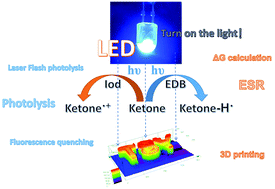In silico rational design by molecular modeling of new ketones as photoinitiators in three-component photoinitiating systems: application in 3D printing†
Abstract
One of the main challenges in the field of 3D printing/vat photopolymerization is the poor adaption of existing commercial photoinitiators (PIs) for the recently popular 3D printers with the irradiation wavelength at 405 nm. It is thus desirable to design and develop high-performance PIs which can work efficiently at this wavelength. In this work, different ketones were specifically designed by molecular modeling for good light absorption properties at 405 nm and the best theoretical structures showing intense violet/blue light absorption were synthesized for further investigation. The new proposed ketones were used in conjunction with different tertiary amines (e.g. ethyl dimethylaminobenzoate (EDB) or triethanolamine (TEA)) and iodonium salt as photoinitiating systems (PISs) for the photopolymerization of trimethylolpropane triacrylate (TMPTA) and Ebecryl 40 (a tetrafunctional polyether acrylate) via an oxidation–reduction reaction mechanism. The results demonstrate that several ketone-based PISs can initiate free radical photopolymerization. The final conversions of Ebecryl 40 resin are higher than those of TMPTA, particularly in the presence of TEA. In addition, the light absorption properties and the photoinitiation mechanisms are also studied using UV-Visible absorption spectra, cyclic voltammetry, and fluorescence approaches. Moreover, the formation of the radicals is clearly determined by the electron spin resonance (ESR) spin-trapping experiments. Finally, the developed ketone-based three-component systems are applied to the generation of macroscopically stereoscopic letter patterns using the 3D printing technique. This research is expected to offer some fresh insights into photopolymerization reactions with three-component photoinitiating systems used in 3D printing. All this work shows that the in silico rational design of new photoinitiators by molecular modeling for specific wavelength (here 405 nm) and specific applications is a powerful tool for the development of high performance photosensitive resins.

- This article is part of the themed collection: Polymer Chemistry Most Popular 2020


 Please wait while we load your content...
Please wait while we load your content...